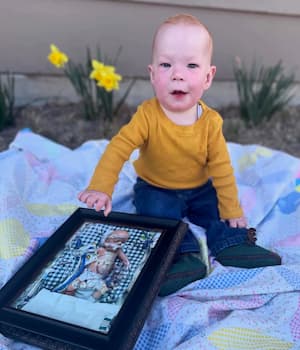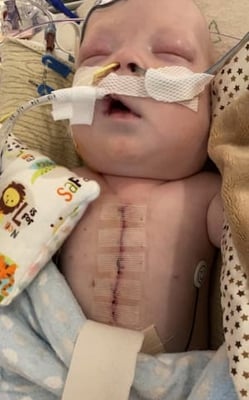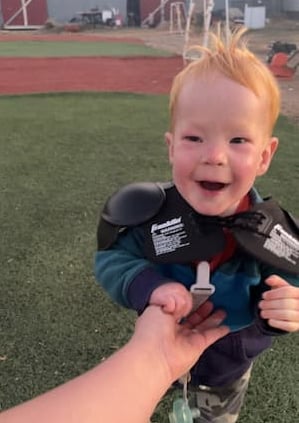Tiny heart, beating strong
Open-heart surgery at 3 months old gives one brave boy a brighter future
Meet Johnny

Parents Tanner and Katerina haven’t been sleeping well.
Their youngest, Johnny, is about 2 years old and teething, keeping them up. But Amanda McIntosh, MD, his pediatric cardiologist, couldn’t be happier about it.
“I think that's my favorite part,” Dr. McIntosh said, “seeing him meet those ordinary toddler milestones. You get these fragile, tiny babies, and then you get them through the hard stuff.”
The hard stuff, in Johnny’s case, started before he was born. When Katerina was about 22 weeks pregnant in October 2022, doctors in the family’s hometown of Hays, Kan., noticed concerns with Johnny’s heart and referred her to specialists, who detected a narrowing in Johnny’s aorta.
However, during a routine checkup a couple months later, Katerina’s blood pressure spiked. When her condition hadn’t improved by that evening, she was flown to Kansas City and admitted to University Health Truman Medical Center. Doctors there partnered with the team at Children’s Mercy to keep an eye on Katerina’s blood pressure and also let Johnny grow as long as possible.
Special delivery, just in time for Christmas
At around 34 weeks, just before Christmas in 2022, doctors couldn’t wait any longer and delivered Johnny via C-section: 4 pounds, 11 ounces, plus a diagnosis of critical aortic valve stenosis. The condition was caused by a rare genetic disorder that affected Johnny’s FOXP1 genes. The mutated gene prevented Johnny’s aortic valve from opening or closing completely, which made his heart inefficient and unable to pump the normal amount of blood.
While Johnny was stable, the excitement of his birth, Johnny’s dad Tanner said, was soon replaced by worry.
“We had no idea what the road ahead was for us,” he said. “It wasn't until about two weeks after. That's when things kind of took a turn.”
Long drives but lots of hope

To get the care they needed, the family stayed in Kansas City through Christmas, and had to travel back and forth between Hays and Kansas City – a four-hour trip each way – to care for their other children and continue working. Tanner was at work when he got the call that first week of January.
“It was one of the nurses letting us know that Johnny had been transported to the cardiac ICU. She said Johnny was showing signs that his body was in distress. I went home, packed my bags, and was on the road within an hour. It was total freak-out, man. I think I made it to Kansas City in record time.”
An echocardiogram showed Johnny’s heart ejection fraction – the percentage of blood pumped out with each heartbeat – was at an alarmingly low 11%. Johnny was prepped for a cardiac catheterization, and Toby Rockefeller, MD, faced the formidable challenge of passing a balloon up his aortic valve that, due to Johnny’s tiny size, was only millimeters in diameter.
“Everyone kind of gritted their teeth,” Dr. McIntosh said, “but we knew he needed it because his heart function was just going down.”
That first balloon aortic valvuloplasty (a forced expansion of a valve by balloon inflation) worked for a while but ultimately needed to be repeated. Johnny returned to the cath lab for a second procedure, followed by several weeks in the hospital. He finally reached the necessary milestones that allowed him to return home in mid-February.
Ready or not, it’s surgery time

The balloon valvuloplasties were only a temporary solution to Johnny’s heart problems. Dr. McIntosh told the family to prepare for the inevitable heart surgery Johnny would need. While they hoped to give him a couple years of growth first, a follow-up appointment just two weeks after discharge showed no improvement, so the team scheduled a date for open-heart surgery — at just three months old.
“That was the turning point,” Tanner said. “There really was no other option.”
Pediatric cardiovascular surgeon William Douglas, MD, performed the Ross-Konno procedure to replace Johnny’s damaged aortic valve with his pulmonary valve, and then replace the pulmonary valve with a cadaver valve. Johnny was on the table for eight hours.
“It was a pretty intense surgery,” Tanner said. “Essentially, his aortic valve was the size of a drinking straw. I was in total panic.”
But after hours of worrying, crying and praying, Dr. Douglas emerged with good news.
“He said he never could have done the surgery if Johnny wasn't as strong as he is,” Tanner said. “He was very pleased and said it went about as good as he envisioned.”
Dr. McIntosh agreed that Johnny’s strength – and that of his family – made all the difference through the entire journey.
“Johnny hasn't had the smoothest course. But the family rallies, Johnny rallies, and we get through it,” she said. “The family recognizes that things aren't going to be smooth, but they always have such a positive attitude and they ask the right questions.”
Proactive care for a better tomorrow

Johnny’s story is far from finished, of course. He had to return to the cath lab seven months after his surgery for stenting of his pulmonary artery, and eventually the cadaver valve will need to be replaced as he grows. The mutated FOXP1 gene also means he’s at greater risk for hearing, speech and vision problems and slower neurological growth. Thankfully, Johnny is connected with the cardiac neurodevelopmental team for speech therapy, physical therapy, occupational therapy and other early interventions, which will allow his team to “anticipate things as much as we can before they happen,” said Dr. McIntosh.
Despite the difficult first year of their son’s life, Tanner said the family only feels a sense of gratitude.
“I kind of get emotional a little when I talk about Children's Mercy because they really are like family,” he said. “It's such a relief knowing there are nurses who take that much pride and dedication in their job. We're really blessed to have experienced Children's Mercy the way we did.”
For now, the family is simply enjoying the opportunity to finally all be together in one place, enjoying a little calm, and reveling in the simple frustrations caused by issues that are, well, a little less life-threatening — like teething.
“The parents tell me, ‘You know, I haven't thought about him having a heart issue for eight weeks,’” said Dr. McIntosh. “I tell 'em, ‘That's what I want. That's why we do all of this.’”
